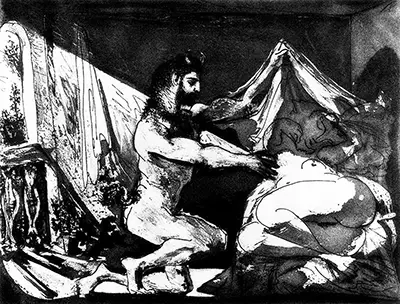Faun Unveiling a Sleeping Girl (1936) is the 97th image in this neoclassical series, the last three etchings being portraits of Vollard himself. The collection had been started in 1930 and Picasso continued to work on it until 1937. The style of the works were greatly influenced by the artist’s travels to Rome, Naples, Pompeii and Florence. A range of techniques were used in the series including etching, burin, dry point, aquatint and sugar aquatint. Faun Unveiling a Sleeping Girl is the most outstanding example of this last technique. A drawing is made on a plate with India ink and sugar water. Layered asphalt varnish was then added and the plate was immersed in water. The dissolving sugar ruptured the varnished layer and lifted it off.
In the Suite, a variety of themes were depicted.The images were not numbered or ordered, but they did contain a number of interwoven themes, such as the sculptor in his studio, a subject which is featured in 47 out of the 100 prints. The studio prints relate to the time that Picasso spent at Chateau Boisgeloup in the French countryside and that this was a happy period in his life, reflects in the subjects of the images. His muse and mistress, Marie-Thérèse Walther, features often in these images. Other themes include the Minotaur, an exploration of Picasso’s strong connection to mythology.
Picasso completed most of the prints to his satisfaction in a single state, although some exist in several states (14 in one example). The Faun Unveiling a Sleeping Girl went through 6 transitions before Picasso arrived at the finished article. Originally drawn with simple lines and shading, the image developed into rich tonal greys, conveying dramatic light and shade. An interesting change that evolved through each state was the transformation of the potted plant (in front of the balcony). Starting life as a strawberry plant it eventually ends as basil. Basil, according to Mediterranean legend, could magically transform animals into magnificent beings, especially during a full moon. As with many artists the story is often in the details as much as the main subject.
The print is directly modelled upon ‘Jupiter & Antiope', a 1659 engraving by Rembrandt. In the image of the Faun, Picasso could be reflecting on his experiences as a casanova, a cheerful and contented lover. At the time that this image was created, Picasso was reaching the end of his 10-year passionate affair with Marie-Thérèse, his eye having wandered again to another lady. The idea of a figure watching another sleeping is repeated often throughout Picasso’s career and is often attributed to the fact that the artist liked to work at night and therefore would have spent many an hour watching his sleeping companions.

